Madeley, Shropshire
Up to 1834
Much Wenlock had a workhouse by 1732. It was a stone building on the north side of Downs Lane, just beyond Farley Brook, and in 1776 could accommodate 30 paupers. In 1777, the parish also began renting a house for poor families. In 1780, the vestry started subscribing to the Salop Infirmary, with an apothecary being retained to attend workhouse inmates from 1788. From 1826, a surgeon was retained for the benefit of all the town's poor within a five mile radius. In 1793, all 27 of the workhouse inmates were women or children. The older pauper children were usually apprenticed to Lancashire cotton mills. In 1834, there were six men, six women and eight children in the workhouse, with the men employed in road mending.
A Broseley parish workhouse existed at Harris's Green from as early as 1734. In 1776, it could house up to 40 inmates.
Little Wenlock had a poorhouse by 1750. It also farmed its poor out to a private contractor based in Wellington. The parish opened its own workhouse in about 1814 at Little Worth.
From around 1766, the poor of Madeley were "farmed" by a contractor who operated a workhouse at Madeley Wood, but the parish took over direct responsibility in the 1780s. In 1796-7, the parish spent £1,000 on erecting a new workhouse at what is now 13 Belmont Road, Brockholes.
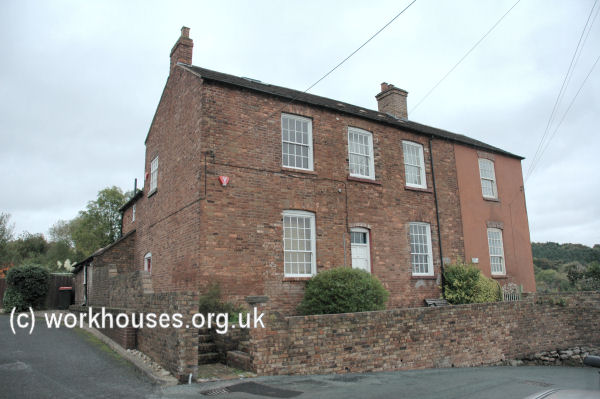
Former Madeley workhouse, Brockholes, 2006.
© Peter Higginbotham.
In 1777, a parish workhouse for up to twelve inmates was in operation at Buildwas. It occupied a timber-framed cottage on Leighton Road.
In the early 1800s, Benthall had a parish workhouse or House of Industry at Mine Spout, in a building dating from the seventeenth century. The property is now a private residence known as The Bayliffe's House.
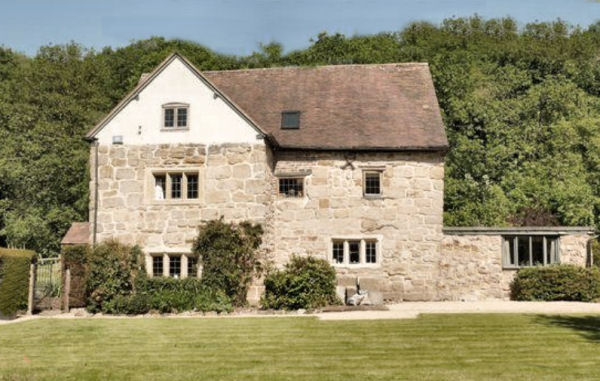
Former Benthall workhouse.
From about 1784, Dawley had a workhouse in a rented property. In 1813, the parish purchased premises for its own House of Industry on Bank Road.
After 1834
Madeley Poor Law Union officially came into existence on 6th June 1836. Its operation was overseen by an elected Board of Guardians, 30 in number, representing its 12 constituent parishes as listed below (figures in brackets indicate numbers of Guardians if more than one):
County of Salop: Barrow, Benthall, Broseley (5), Buildwas, Dawley Magna (7), Linley, Madeley (6), Posenhall, Stirchley, Little Wenlock (2), Much Wenlock (3), Willey.
The population falling within the Union at the 1831 census had been 22,164 with parishes ranging in size from Posenhall (population 28) to Dawley Magna (6,877) and Madeley itself (5,822). The average annual poor-rate expenditure for the period 1833-5 had been £6,852 or 6s.2d. per head of the population.
The Madeley Union took over the former parish workhouses at Brockholes, which became the union's main workhouse, and at Broseley, which was used to house aged inmates. Broseley was closed in 1838 but the premises were retained by the union and subsequently re-used.
In 1842, the Commissioners investigating the employment and conditions of children in mines and manufactories, discovered that workhouse boys, some as young as eight, were being sent on "apprenticeships" of up to twelve years working in coal mines. As a result, some unions in the coal-mining districts of South Staffordshire and adjacent areas were asked to provide detailed information on the children who had been apprenticed in the mining industry in recent years. Madeley recorded only two such cases, both dealt with by parish officers rather than the Board of Guardians. John Weager, aged 10, was apprenticed in February 1839 to Joseph Bullin, Charter-master of Wolverhampton, until aged 21, with no premium paid. Henry Williams, aged 10, was apprenticed in March 1840, to Henry Pott, collier of Wolverhampton, until aged 21, again with no premium.
By the 1860s, the Poor Law Board applied increasing pressure on the Madeley guardians to replace the Brockholes building which they regarded as unsuitable for continued use. Eventually, in December 1868, the Board decided to close down the workhouse, forcing the the guardians to provided a new building. The old building was subsequently sold off and converted to housing — what is now 13 Belmont Road, Ironbridge.
The workhouse was erected in 1871-5 at a site on Beech Road, just to the north of Ironbridge. It was designed by G.C. Haddon and is thought to be the first workhouse to fully adopt the pavilion-block layout. It was constructed in pink-brown brick decorated with yellow, red and blue brickwork. The site location and layout are shown on the 1901 map below.
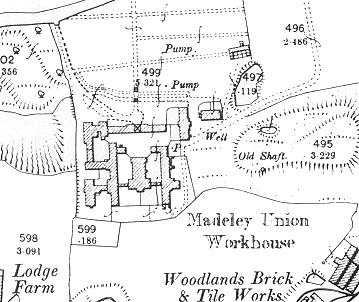
Madeley workhouse site, 1901.
The workhouse had a long front block with an entrance archway at its centre.
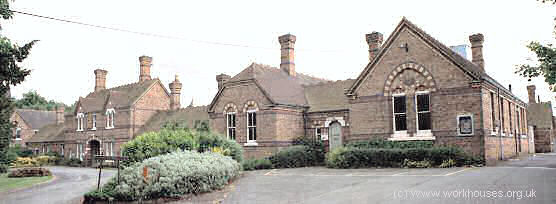
Madeley main entrance block from the north-west, 2001.
© Peter Higginbotham.
To its rear, a central pavilion contained a kitchen at its northern end and a chapel at the south.
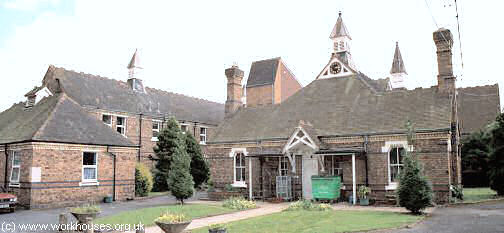
Madeley central block kitchen from the north-east, 2001.
© Peter Higginbotham.
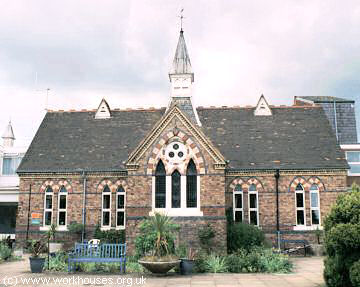
Madeley chapel from the east, 2001.
© Peter Higginbotham.
The central block was flanked by the inmates' accommodation pavilions, with males housed at the east and females at the west.
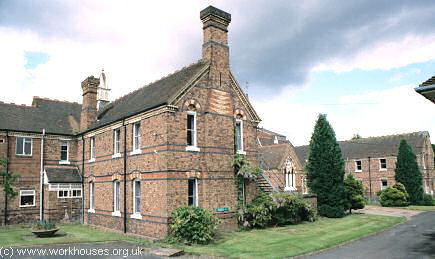
Madeley from the south-west, 2001.
© Peter Higginbotham.
An infirmary, later extended, was placed at the north-east of the site.
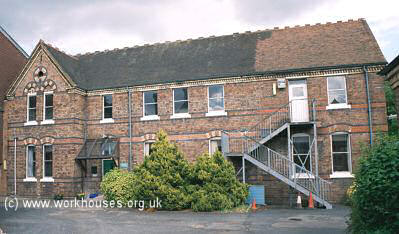
Madeley infirmary from the south-west, 2001.
© Peter Higginbotham.
After 1930, the workhouse became the Ironbridge Public Assistance Institution and provided accommodation for the chronic sick and also for cases of epilepsy. After 1948, it joined the National Health Service as Beeches Hospital, then became the Lincoln Grange care home for the elderly. In 2018, after a decade of standing empty, work began to convert the buildings for residential use.
Staff
Inmates
Records
Note: many repositories impose a closure period of up to 100 years for records identifying individuals. Before travelling a long distance, always check that the records you want to consult will be available.
- Shropshire Archives, Castle Gates, Shrewsbury, Shropshire SY1 2AQ. Please note that records may contain gaps or have access restrictions - please check before visiting. Holdings include: Guardians' minutes (1836-1930); Relief order books (1848-1930).
Bibliography
- Jones, Ken (2009) Pitmen, Poachers and Preachers: Life and the Poor Law in the Madeley Union of Parishes 1700-1930 (Book + CD)
Links
- None.
Unless otherwise indicated, this page () is copyright Peter Higginbotham. Contents may not be reproduced without permission.


